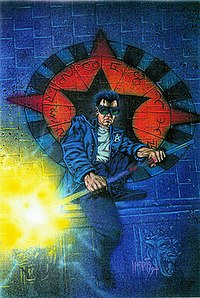 |
| Jack Knight, From Wikipedia |
Then came Starman.
As created by writer James Robinson and artist Tony Harris, Starman is Jack Knight — a small figure of a man, a tattooed late-20-something, obsessed with all things rare and antique. He'd rather scour rural flea markets for View Master reels and Depression glass than dress in Spandex and duke it out with the villains.
His idea of a costume is night-vision goggles and a leather jacket.
But as the younger son of a 1940s superhero, Jack has become the epitome of the chicken-or-egg question that haunts history: Do great events conspire to create heroes, or do great men and women arise to make history?
In Jack's case, events sought him out and he rose to the challenge. His big brother, David, was first to don Dad's mantle, only to be killed by a sniper's bullet in the first pages of the first issue.
(Jack has since had two surreal visits with his deceased brother — the first as they fought in a grave yard over the right to the Starman name, and the second as David sought to warn Jack of future events.)
With his father injured, his brother dead and his own antique shop razed by the children of an old foe, Jack uses his dad's "star rod" to rout the bad guys and restore order to Opal City.
Through Jack and his supporting cast, Robinson has crafted a book with the multiple layers of history, personality, foreshadowing and drama usually found only in works print-only fiction. His characters are distinct and react with realism — as seen in the frustration and distance between father and son that slowly dissolves into a growing respect and admiration for their individual strengths.
The periodic "Times Past" stories allow guest artists to explore events in the history of Opal and its citizens, giving us a glimpse of the Golden Age of heroes; or a tale of the nigh-immortal. sometimes-villainous Shade and his friendship with Oscar Wilde.
Meanwhile, artist Harris has crafted a vision of retro-deco cities, of characters delineated by quirky swirls and outlines, of shadows and black bordered pages. No larger-than-life people dominate his panels — save for the lumbering Solomon Grundy. Though stylistically rendered, these are anatomically realistic human beings with an expressive range far removed from the grimacing brain-bashers in other comix.
Like our own shared version of reality, this can be a dark world. People die. Bad guys revel in the pain of others. Some cops are less-than-true to their code. Evil is powerful.
But now there's a beacon in the night.
"Starman has always been around," Robinson said in his introduction to the series, "a light in the darkness, in his own little corner of the DC universe."
No comments:
Post a Comment